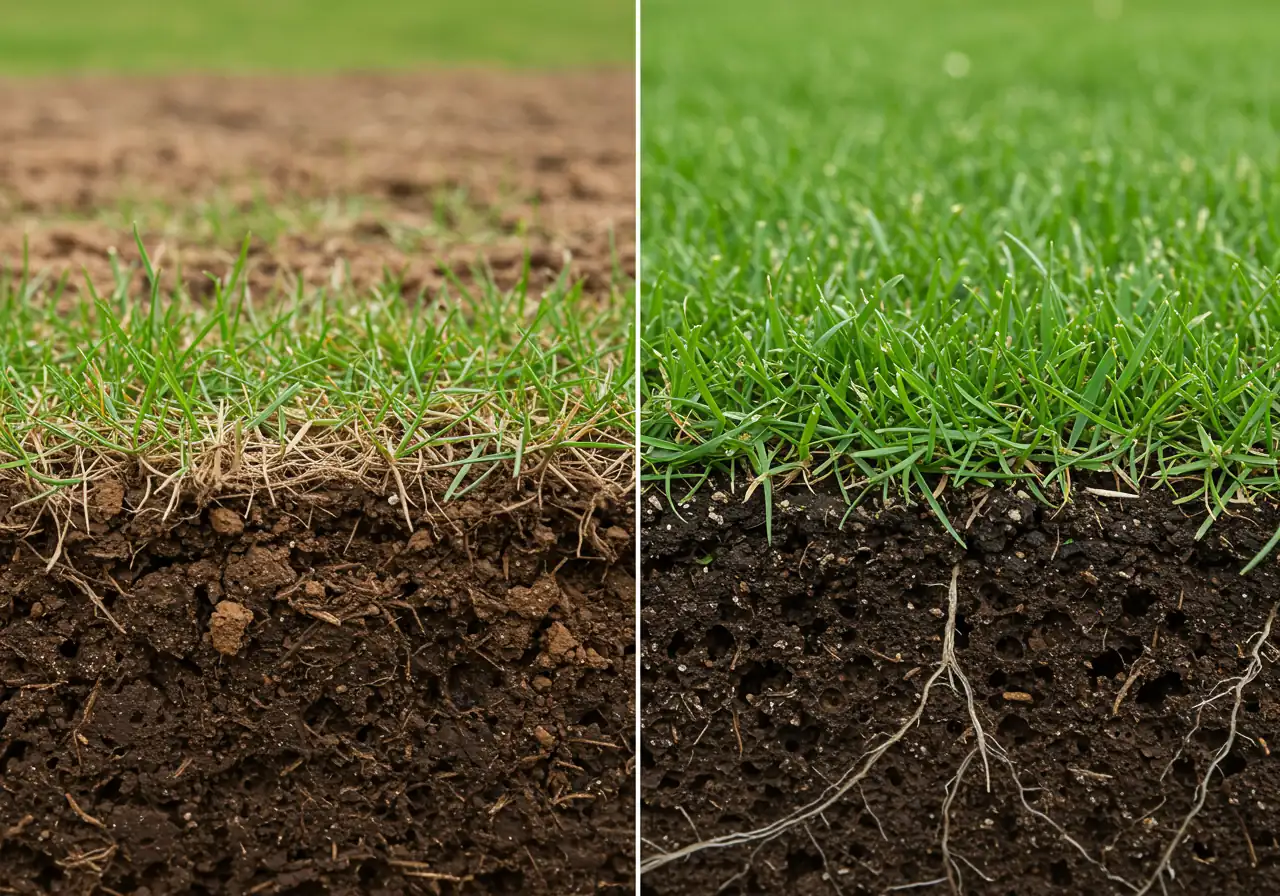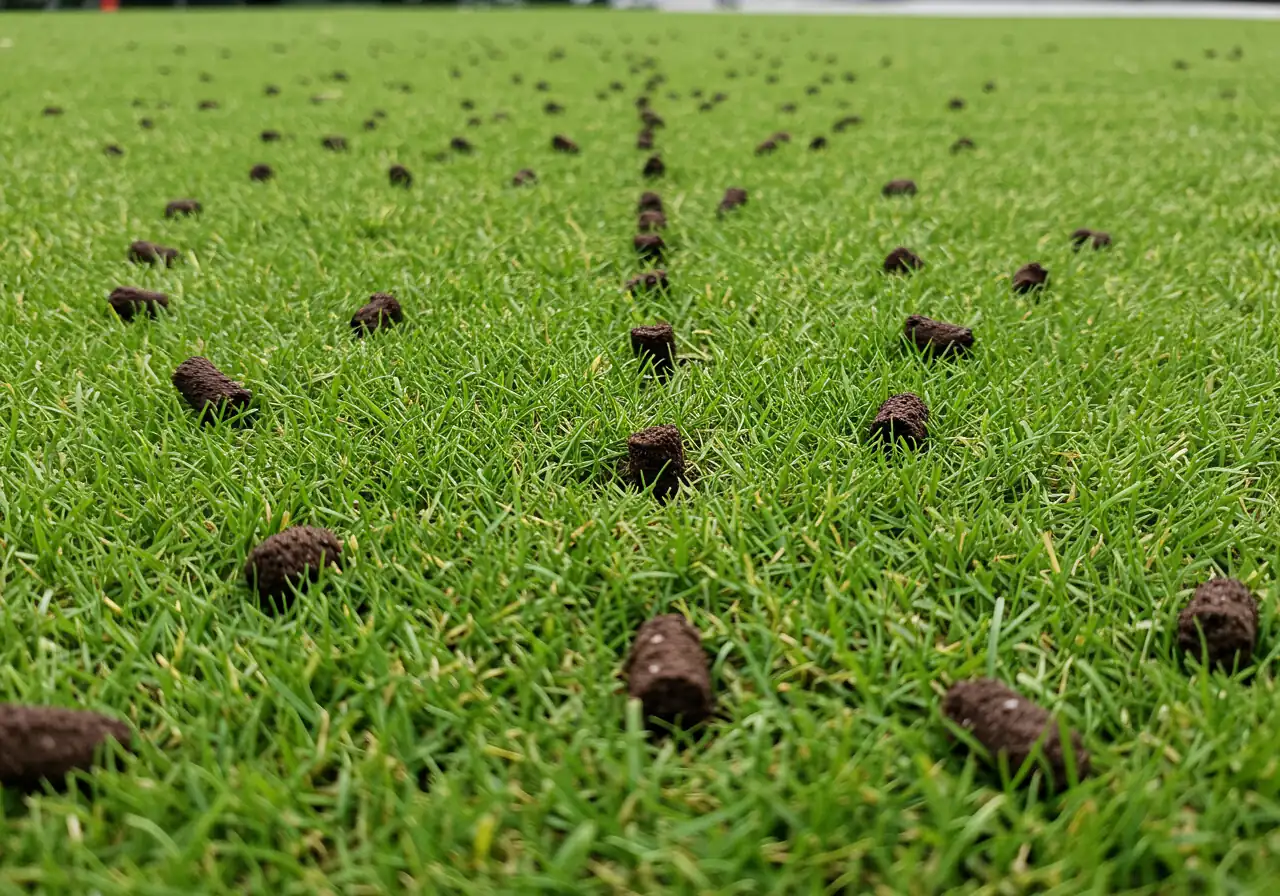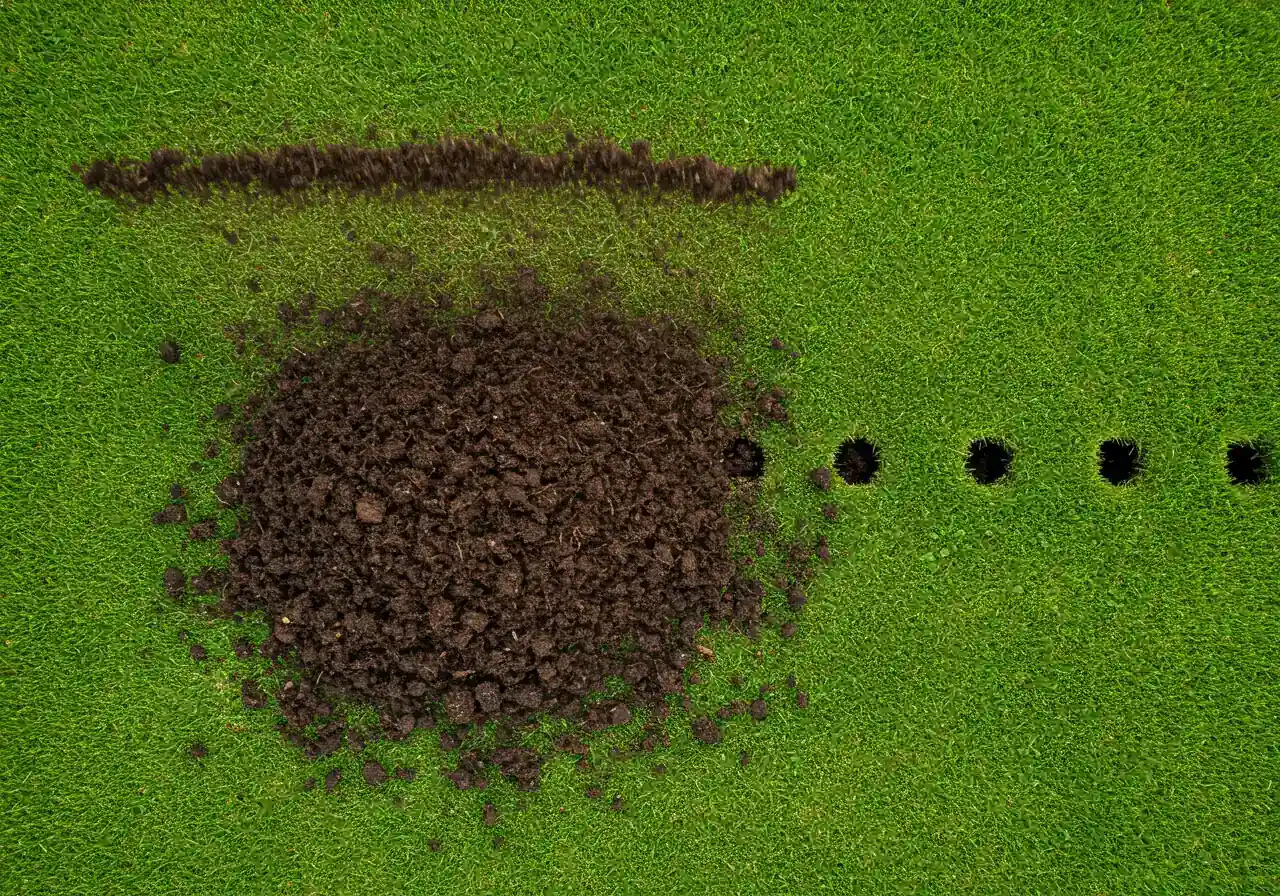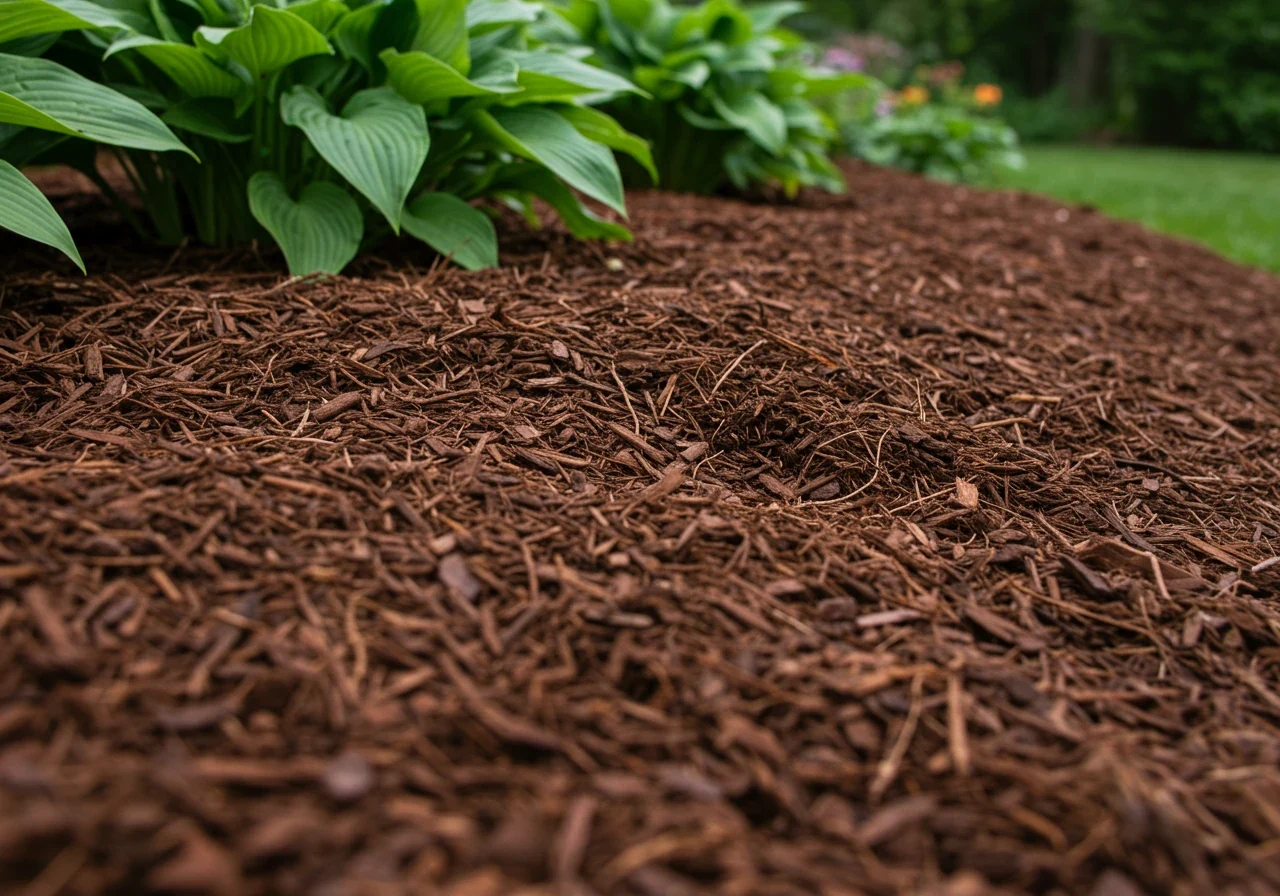Nepean Construction Mess? Fix Compacted Soil This Spring
Quick Fixes for Compacted Soil:
- Problem: Heavy construction equipment or foot traffic compacts Nepean soil (often clay-heavy), blocking air, water, and nutrients.
- Symptoms: Puddling water, runoff, thin/yellow grass, struggling plants, hard ground.
- Solutions: Core aeration, adding organic matter (compost), topdressing lawns.
- Prevention: Use paths, mulch garden beds, water deeply, choose native plants.
Is your yard showing signs of stress after recent construction? Don't let compacted soil ruin your lawn and garden. Request a free quote today and let Clean Yards help bring your Nepean property back to life!
Introduction: Nepean Construction Blues? Your Lawn Doesn't Have to Suffer!
Okay, Nepean homeowners, let's talk. Did it feel like that construction crew practically moved into your backyard last season? Maybe a backhoe became your unofficial, *very* heavy lawn ornament? We get it. The dust finally settles, the noise stops, but then you look at your lawn and... yikes. Beyond the muddy tracks, there's often a hidden villain left behind by all that heavy equipment: soil compaction.
Think of it like your lawn's soil holding its breath – tightly packed down by machinery and foot traffic, making it tough for water, air, or vital nutrients to reach the thirsty grassroots. It's a common landscaping headache after projects wrap up, whether you're in Nepean, nearby Barrhaven, or anywhere across the Ottawa area where progress meets property lines. Check out our Google My Business page for reviews from satisfied Ottawa clients.
But don't despair! Your lawn doesn't have to suffer these construction blues forever. Soil compaction might be tough, but it's fixable. Spring is the perfect time for a lawn care comeback, and we've got the simple, actionable gardening tips – like core aeration, topdressing, and overseeding – ready to help your Nepean lawn breathe easy, recover its strength, and get back to its glorious green self. Let's get started!
The Heavy Truth: What Soil Compaction Does to Your Ottawa Yard
Okay, let's dig into the nitty-gritty – literally! What exactly *is* soil compaction, and why should your poor Ottawa lawn be so worried about it, especially after the construction crews pack up and leave Nepean?

Imagine your healthy lawn soil is like a fluffy sponge. It's got lots of tiny pockets (pores) that hold air and water. Plant roots love this! They can easily wiggle through, sip water when thirsty, and breathe in the oxygen they need. Happy roots mean happy grass and gorgeous garden plants. You can explore some stunning results in our Transformations gallery.
Now, picture someone taking that sponge and squishing it flat. That's soil compaction! All that weight from heavy machinery rolling back and forth, piles of lumber sitting for weeks, or even constant foot traffic in the same area squeezes those precious air and water pockets right out of the soil. The soil particles get packed tightly together. This is especially common here in Ottawa, where many neighbourhoods, from established areas undergoing renovation in Manotick to newer developments, often deal with heavy clay soil. Clay particles are super tiny and love to stick together, making them extra prone to compaction – think of it less like a sponge and more like modelling clay under pressure.
So, what’s the big deal? What’s the “heavy truth” about what this does to your yard?
- Water Woes: Compacted soil can't absorb water properly. Rain or sprinkler water tends to puddle on the surface or just run off, taking valuable topsoil and fertilizers with it. Instead of soaking down to the roots, it might just make a muddy mess or disappear down the storm drain. This poor drainage can cause issues year-round, and being prepared for seasonal changes is key; for instance, ensuring proper water management before winter is crucial, which relates to tasks like Nepean Irrigation Winterization to Avoid Pipe Damage.
- Suffocating Roots: Plant roots need space to grow and access to oxygen in the soil. When the soil is brick-hard, roots struggle to penetrate deep. They stay shallow, making your lawn much less tolerant to drought, heat, or cold. It’s like telling them to thrive while stuck in a too-tight pair of shoes!
- Nutrient Lockout: Those squeezed-out pore spaces are also highways for nutrients travelling through the soil to the roots. Compaction basically creates roadblocks, preventing your grass and plants from getting the food they need, even if you fertilize regularly. Improving this access is a major benefit of services like Nepean Spring Lawn Aeration in Ottawa, which directly tackles compaction.
- Weakened Defenses: A stressed lawn with shallow roots and poor nutrient uptake is way more susceptible to pests and diseases. It just doesn’t have the strength to fight them off. Keeping an eye on your garden's vitality, especially during seasonal transitions described in our Nepean Fall Garden Health Checks guide, becomes even more important.
- The Ugly Truth: The end result? You’ll likely see thinning grass, yellowing patches, bare spots where nothing wants to grow, and generally a lawn that looks tired and unhappy. It impacts the whole look and feel of your yard, something we touch upon when discussing overall aesthetics in posts like Nepean Fall Garden Prep for Colour & Winter Tips.
Recognizing these signs is the first step towards recovery. If your Nepean yard, or anywhere else in the Ottawa region, is showing these symptoms, especially after construction or heavy use, compaction is a likely culprit. Understanding the problem helps you seek the right solutions, whether it's specific lawn treatments or broader maintenance. Explore our range of Landscaping and Yard Cleanup Services to see how we can help revive your soil. And if construction specifically left your yard looking worse for wear, our targeted Nepean Yard Cleanup Service is designed to address just that kind of challenge.
For helpful tips on managing garden waste, check out the City of Ottawa's resources on Leaf and Yard Waste Collection.
Is Your Soil Suffocating? Signs of Compaction After the Crew Leaves
Alright, the trucks have rolled away, the noise has stopped, and maybe that new patio or fence looks great! But take a closer look at the surrounding ground, especially in areas where heavy equipment roamed or materials were piled up in your Greely or Manotick yard. Does something still seem… off? Your soil might be silently suffering from compaction, basically holding its breath after all that commotion.
Think your Ottawa soil might be packed down tighter than a rush-hour bus? Here are some tell-tale signs the crew might have left behind more than just a few stray nails:
- Puddle Problems: After a good rain or watering, do you notice water pooling on the surface for longer than it should? Compacted soil acts more like pavement than a sponge, preventing water from soaking in.
- Runaway Water: Instead of sinking in, does water seem to just sheet off the surface, especially on slight slopes? That’s another sign the soil pores are slammed shut.
- Struggling Greenery: Is your grass looking thin, patchy, or yellowish despite your best efforts? Are newly planted flowers or shrubs just sitting there, refusing to thrive? Compacted soil makes it tough for roots to penetrate and find nutrients. Proper Garden Maintenance becomes a real uphill battle.
- Bare Bones: Are there spots where grass simply *refuses* to grow, no matter how much seed you throw down? Extreme compaction can make areas almost impossible for plants to colonize. This is a common issue addressed during post-construction recovery, similar to tasks handled by our Nepean Yard Cleanup Service or City Yard Cleanup Service for homes over there.
- Rock-Hard Ground: Does digging feel like trying to chip away at concrete? Healthy soil should be relatively easy to turn or dig into.
Try the Screwdriver Test!
Here’s a super simple gardening trick: Grab a regular screwdriver (a long one works best). A day or so after a decent rain or thorough watering (don't try this on bone-dry soil!), try pushing it into the lawn in different areas.
- Easy Peasy: If it slides in fairly easily for several inches, your soil is likely okay in that spot. Phew!
- Hard Going: If you meet serious resistance after only an inch or two, or can barely push it in at all – uh oh. You’ve likely found a compacted area.
Compaction isn't just a problem in large suburban yards; even small urban plots can suffer, affecting the success of services like our City Garden Clean Up Service. Recognizing these signs, whether you're in Greely or require a Metcalf Garden Clean Up Service or even a Marionville Garden Clean Up Service, is the first step to helping your soil breathe again. Spotting these issues and wondering about next steps? Feel free to Contact Us to chat about solutions – and rest assured, any information you share is handled according to our strict Privacy Policy.
Spring Remediation Toolkit: Breathing Life Back into Your Compacted Soil
Okay, so your soil is basically holding its breath, feeling squished and stressed after the construction hustle. Don't worry, even the most compacted yards in places like Osgoode or Metcalfe can learn to breathe again! Spring is the perfect time to open up your soil remediation toolkit. Let's unpack the best ways to loosen things up and get your lawn and garden beds thriving.
1. Core Aeration: The Deep Breath Your Lawn Needs
Think of core aeration as giving your lawn a much-needed spa treatment. This process involves a machine pulling small plugs (cores) of soil out of the ground. It sounds a bit aggressive, but trust us, your lawn will thank you!

Why it Works: Those little holes are lifelines! They break through the compacted layer, allowing precious air, water, and nutrients to penetrate deep down to the grassroots. It’s often the single most effective first step for tackling serious compaction, especially in turf areas.
Post-Aeration Power Moves:
- Leave the Cores: Resist the urge to immediately rake up those soil plugs! As they break down, they return valuable nutrients and microbes back into the soil surface.
- Water Well: Give your lawn a good drink after aeration.
- Topdress Time: Perfect opportunity to spread a thin layer of compost.
- Overseed Opportunity: Great time to scatter grass seed for direct soil contact.
- Feed if Needed: Fertilizer gets down to the roots more effectively.
Aeration is a key part of many comprehensive yard care plans, like those offered by an Ottawa Garden Clean Up Service or Ottawa Yard Cleanup Service focused on getting your entire space back in shape.
2. Bring on the Organic Matter: Food for the Soil
Compacted soil is often lifeless soil. Adding organic matter is like giving it a nutritious meal and a dose of probiotics! Things like compost, aged manure, or leaf mold work wonders.

Why it Works: Organic matter improves soil structure. It helps bind sandy soils together and break up heavy clay particles (hello, much of Ottawa!). It also feeds essential soil microbes, which are tiny workhorses that help keep soil healthy and loose. Proper Soil Preparation almost always involves adding organic goodies, sometimes selected during our Material Selection process.
Which Organic Goodness to Choose?
| Feature | Compost | Aged Manure | Leaf Mold |
|---|---|---|---|
| Main Benefit | Balanced nutrients, adds humus, versatile | Higher NPK, improves soil structure | Excellent soil conditioner, improves water retention |
| Best For | General garden use, topdressing lawns | Vegetable gardens, nutrient-hungry plants | Improving clay soil, mulching beds |
| Caution | Quality can vary; avoid "hot" compost | *Must* be well-aged (not fresh!) | Can be slightly acidic; breaks down slowly |
You can work organic matter into garden beds or use fine compost for topdressing lawns (especially after aeration!).
3. Topdressing: The Smoothing Touch
Topdressing is simply applying a thin layer (usually ¼ to ½ inch) of a soil mix, compost, or sand/compost blend over your lawn or garden beds.
Why it Works: For lawns, it helps level uneven areas, improves the soil profile over time (especially when filling aeration holes), reduces thatch buildup, and creates a great seedbed if you're overseeding. Think of it as smoothing things out and adding a beneficial layer. Improving yards in specific areas often involves this technique; for instance, a targeted Metcalf Garden Clean Up Service might use topdressing to address localized compaction or unevenness.
4. Cover Cropping: Nature's Soil Builders
This is a fantastic gardening technique, especially for vegetable beds or areas you plan to plant later. You essentially plant specific crops *not* for harvest, but to benefit the soil itself.
Why it Works: The roots of cover crops like oats, rye, buckwheat, or certain clovers penetrate and break up compacted soil naturally. When you cut them down (or gently till them in *before* they go to seed), they add valuable organic matter right back into the ground.
Ottawa Considerations: Given our shorter growing season, fast-growing options like buckwheat (summer) or fall rye (overwintering) work well. They prevent erosion on bare soil and actively improve it. Watching a neglected patch turn into healthy soil through methods like this is part of the magic you can see in our project Transformations.
5. A Word of Caution: Go Easy on the Tiller!
It might seem like the obvious solution: just churn up that hard soil! But hold on – excessive tilling can actually do more harm than good.
Why it's Risky: Tilling pulverizes natural soil structure (those aggregates organic matter helps build), can create a compacted layer *below* the tilled zone (hardpan), kills beneficial earthworms and microbes, and often brings dormant weed seeds to the surface. Uh oh.
When is it Okay? Maybe for initially incorporating large amounts of organic matter into *severely* degraded or compacted soil in a new garden bed. But for routine maintenance? Usually not the best idea. Minimal disturbance is often the better long-term strategy. Professional teams, like those handling a City Property Cleanup Service, understand the importance of using the right techniques, including knowing when *not* to till aggressively.
Bringing compacted soil back to life takes a bit of effort, but combining methods like aeration and adding organic matter yields the best results. Remember, healthy soil is the foundation of any great lawn or garden! And if you're considering professional help for these tasks, understanding the scope of work is key; it's always wise to be familiar with service agreements, such as our standard Terms and Conditions. Now, let's get that soil breathing!
Benefits of Soil Remediation Over Time
*Illustrative soil health improvement percentage.
Keeping it Healthy: Long-Term Soil Care & Eco-Friendly Practices for Ottawa Yards

Alright, so we’ve talked about rescuing your soil from the squish-zone after construction. High five! But like preventing that awkward moment when you realize you left the house in slippers, preventing *future* soil compaction is way easier (and better for your yard!) in the long run. Let's chat about keeping your Ottawa soil happy, healthy, and breathing easy for years to come, using smart, eco-friendly habits.
Be Kind to Your Ground: Managing Traffic
Think about where you, your family, and even your car tend to tread most often. Constant pressure is compaction's best friend!
- Create Clear Paths: Use stepping stones or mulch pathways for high-traffic routes.
- No Parking on the Grass! Keep vehicles on the driveway.
- Spread the Love (and Footsteps): Encourage guests to mingle rather than cluster.
- Mind the Machinery: Be mindful of equipment travel during projects. Professionals handling tasks like a Metcalf Property Cleanup Service are typically careful, but it's good practice.
Mulch: Your Soil's Protective Blanket
Mulch is like stylish armor for your garden beds. Applying a 2-3 inch layer of organic mulch (like shredded bark, wood chips, or composted leaves) does wonders:
- Cushions the Blow: Softens impact of rain and footsteps.
- Keeps Moisture In: Reduces evaporation – vital for Ottawa summers.
- Smothers Weeds: Less competition for plants!
- Feeds the Soil: Slowly adds nutrients and improves structure. Our Mulching and Edging service can help!
Water Wisely for Deep Roots
Instead of frequent shallow sprinkles, water deeply but less often.
- Why? Encourages deeper roots, making plants stronger and drought-tolerant.
- Eco-Bonus: Reduces runoff, protecting local waterways like the Rideau River. Healthy soil acts as a filter! Learn more about protecting local watersheds from the Rideau Valley Conservation Authority. This commitment is part of our quality Lawn Care approach.
Choose Plants That Love Ottawa (and Your Soil!)
Selecting the right plants makes a huge difference.
- Native Power: Plants native to Ottawa (Coneflower, Joe Pye Weed) are adapted to our climate/soil and often have strong root systems.
- Right Plant, Right Place: Consider light, soil, and moisture. Sometimes, if compaction caused severe damage, starting fresh with Sod Installation after remediation is an option.
Long-Term Thinking & Eco-Friendly Perks
These practices build resilient soil needing less intervention. Healthy soil supports microbes, reduces chemical needs, and manages water effectively. It’s about working *with* nature, whether in Nepean or needing a Marionville Yard Cleanup Service. Implementing these strategies after an initial cleanup, like that from a Metcalf Yard Cleanup Service, ensures sustainable success. Remember, understanding the approach is key – always review details like our Terms and Conditions. Focus on long-term soil health for a beautiful, eco-friendly yard.
Soil Recovery Timeline: A Typical Journey
Spring - Year 1: Intervention
Initial assessment reveals severe compaction. Core aeration performed, followed by topdressing with compost and overseeding thin areas.
Summer - Year 1: Observation
Monitor water infiltration. Practice deep, infrequent watering. Grass shows signs of recovery, new seedlings emerge.
Fall - Year 1: Reinforce
Consider a second aeration if compaction was severe. Apply fall fertilizer. Add mulch to garden beds for winter protection.
Spring - Year 2: Maintenance
Assess lawn density. Perform light aeration if needed. Focus on proper mowing and watering. Soil structure continues to improve.
Ongoing: Prevention
Maintain designated pathways, continue mulching beds annually, stick to deep watering schedule. Soil is now much healthier and resilient.
Key Insights: Your Quick Guide to Fixing Compacted Nepean Soil
The Problem: Why Compacted Soil is a Party Pooper
- What's the Big Squeeze? Soil particles packed tightly (heavy equipment/traffic), squeezing out air/water pockets vital for roots.
- Why It's Bad News: Leads to puddles, runoff, suffocated shallow roots, poor nutrient uptake, weak plants, and poor *gardening* outcomes.
The Fixes: Helping Your Soil Loosen Up
- Breathe Easy with Aeration: Core aeration is key. Pulling soil plugs breaks compaction, letting air, water, nutrients reach roots.
- Feed the Soil (Organically!): Add compost to beds or topdress lawns (great after aeration!). Improves structure, feeds microbes – crucial for good *landscaping*.
- Smooth it Out with Topdressing: Thin layer of soil/compost levels lawns, improves soil surface, helps overseeding.
- When It's Part of a Bigger Mess: Widespread damage might need a comprehensive property clean up. We offer services like Metcalf Yard Cleanup Service or Marionville Property Cleanup Service.
Keeping it Healthy: Long-Term Prevention
- Watch Your Step (Literally!): Minimize traffic on lawns. Use paths. Keep vehicles off grass.
- Mulch is Your Friend: 2-3" organic mulch in beds protects soil, retains moisture, suppresses weeds, improves soil over time.
- Water Deeply, Not Daily: Encourages deep, strong roots less stressed by compaction.
Fixing compacted soil takes effort but yields great results for your Nepean yard. Healthy soil = happy lawn & garden! Need help? Learn more about us. Have feedback on an estimate? Provide estimate feedback here.
Nepean & Ottawa Soil Compaction FAQs
Great question! Much of Ottawa, including areas like Nepean and Barrhaven, has heavy clay soil. Clay particles are tiny and love to stick together. Add the weight of construction equipment or piled materials, and that clay packs down *tight*, squeezing out air and water pockets essential for healthy plant roots. It’s like giving your lawn a concrete hug it didn’t ask for!
Hold your horses there! While tempting, aggressive tilling can actually destroy healthy soil structure, kill beneficial worms, and bring weed seeds up. For lawns, core aeration is usually much better. Tilling *might* be okay for starting a brand new garden bed if you're mixing in tons of compost, but generally, gentler methods are preferred for long-term soil health. Consider professional help for tough spots, like an Ottawa property cleanup service, to assess the best approach.
Spring (around May) and early fall (September) are prime times for aeration here in Ottawa's climate zone. The grass is actively growing, allowing it to recover quickly and take full advantage of the improved air, water, and nutrient access. Avoid aerating during summer drought or deep winter freezes when the turf is already stressed. Regular aeration can be part of ongoing lawn care, similar to our city garden maintenance service.
They can help *eventually*, but severely compacted soil makes it tough for new plants to even get established! Their roots might struggle to penetrate. It’s best to improve the soil *before* planting by core aerating the lawn or incorporating plenty of compost into garden beds. For beautiful results, good soil prep is key before considering a new garden installation.
Prevention is key! Use designated pathways to limit foot traffic on the lawn. Keep heavy vehicles off the grass. Applying organic mulch is fantastic for garden beds – our mulching and edging services can help define and protect these areas. Consistent good practices mean less hard work later. Seeing a healthy yard recover is rewarding; we love hearing from happy clients via our Client Thank You Mentions page!
Conclusion: Reclaim Your Yard and Love Your Lawn Again!
So, there you have it! That stubborn soil compaction left behind after the trucks roll away doesn't have to be the final word on your yard's story. It might feel like your lawn in Nepean or Barrhaven is holding a grudge (and its breath!), but recovery is absolutely achievable. You *can* banish those construction blues and get back to truly enjoying your outdoor space.
Remember those key steps? Giving your soil a much-needed *breath* with core aeration and feeding it nutritious organic matter can work wonders for its health. Think of it as lawn CPR! With a little know-how and maybe some elbow grease (or our help!), you can transform those problem patches. Soon, you could be enjoying lush grass perfect for barefoot summer days in Greely or admiring thriving *garden* beds in Richmond, instead of stressing over compacted dirt. It’s all about reclaiming your little patch of paradise!
Ready to stop battling the compaction frustration and start loving your lawn again?
- Let the pros handle the heavy lifting! Contact Clean Yards today for expert soil remediation and complete lawn care services across Ottawa.
- Get a FREE, no-obligation quote tailored specifically to your yard's post-construction recovery needs via our contact form.
- Explore our full range of landscaping and yard cleanup services to discover all the ways we can help your property look its best. Visit our main Services page for details.

